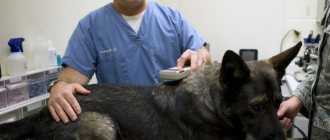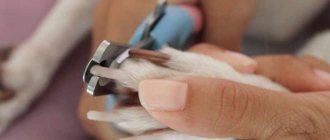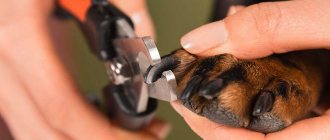Microchipping a dog is a modern way of identifying an animal. The procedure, mandatory in many European countries, is gaining popularity in Russia and the post-Soviet space. In the near future, it will become part of the rules for keeping pet dogs, just like regular rabies vaccination. Unfortunately, not all owners of four-legged pets know about the possibilities and benefits of microchipping.
What is dog microchipping?
Microchipping dogs is becoming an increasingly popular technology, which is based on the use of high-tech sensors. A complex system helps to enter into a national and international database all the information about dogs and their owners.
Type and size of microchip for dogs
The chip, microscopic in parameters, is an inductive coil and a microcircuit soldered into a small tank. The latter is a capsule up to 12 mm long and about 2.1 mm in diameter, made of biocompatible material. This greatly reduces the possibility of the reservoir being rejected or displaced under the animal's skin.
The tank weighs about 0.6 g. There are no power sources, so the shelf life is unlimited. The elements in the composition do not create any radiation and are completely safe for pets. Activation occurs only under the influence of a scanner that creates a small electromagnetic field.
Digital data meaning
A special scanner reads a personal number, which is unique and does not change throughout the dog’s life. This code is entered into a single database and cannot be shortened, changed or supplemented. The number includes 15 characters that have a strictly defined meaning:
- The three digits at the beginning of the code indicate the country. For example, for Russia the code 643 is used.
- The next four characters indicate the device manufacturer information.
- The remaining eight characters contain information about the pet (name, color, breed, information about vaccinations) and the owner (name, contacts).
At the request of the four-legged owners, additional information about the dog’s place of residence, his photograph, and information about his pedigree can be entered into the device.
Common questions about microchipping
Is the procedure always painless?
Yes, sure. A prerequisite is that it is performed by an experienced doctor. An inexperienced doctor may insert the microchip incorrectly, it will get tangled in the fur and get lost.
Is it possible to wash the dog after the procedure?
It is better to postpone washing for a week while the device becomes fouled with fabric.
Can the device deteriorate over time?
Yes maybe. For various reasons: demagnetization, defects and others. Before traveling abroad, you need to check the functionality in the clinic.
How to make changes about the owner if the dog has changed family?
It is not possible to make changes to the device. Exit: remove the old chip, enter a new one with new information.
Necessity of the procedure
An electronic chip for dogs has been mandatory for visiting EU countries since 2010. This is a real requirement for allowing four-legged animals to cross the border, and is intended to prevent the import of infected animals. In addition, implantation will not allow replacement of representatives of elite breeds. The owner or breeder can easily recognize the dog and lay claim to it.
To participate in competitions and championships at the international level, it is necessary to have an implanted microcircuit with the pet’s data. Implantation is also recommended for hunting animals, which often get lost during long walks with their owners.
There is no law in our country that forces or obliges owners and breeders to insert an electronic chip into their dog. However, there are amendments regarding the need to identify and register pets. This means that microchipping of dogs in Russia may soon become mandatory.
Owner reviews
Ivan K.
We are a very active family and travel constantly. We got such an active breed - Jack Russell terrier Archie. We decided right away that the dog would go everywhere with us. I really didn’t want to leave him at home alone. We came to see the doctor about what vaccinations we need to get for a trip to Germany. They explained to us that to cross the border of the European Union countries we would need a chip. It sounded a little scary. But the device turned out to be microscopic. The procedure went quickly and unnoticed. There was no inflammation. We go everywhere. It is very convenient to microchip a dog - in any country the doctor understands the dog’s health status, there is no need to waste time on fussy explanations.
Olga H.
I am a Husky breeder. Microchipping is a mandatory procedure for all puppies in our kennel. Firstly, this is a mandatory condition for participation in exhibitions both in our country and abroad. Secondly, I am not afraid that the dogs may be stolen and tried to be passed off as their own. Such disputes are resolved very quickly by simply bringing the scanner to the dog.
Advantages and disadvantages
Like any veterinary procedure, introducing a microcircuit under the skin of a pet has its supporters and opponents. Therefore, it is important to evaluate its advantages and disadvantages in advance.
Pros of traveling abroad
Unlike a paper veterinary passport, a microchip cannot be lost. This is very important when traveling abroad, traveling by train or plane.
Compared to branding or tattooing a number on a dog's body, a microchip cannot be changed and has no expiration date. In addition, the brand may become overgrown with hair or become distorted. Finally, in European countries and in the United States there is no corresponding database of tattoos.
How to find missing chipped dogs
If lost, it is much easier to find a microchipped four-legged friend than an unchipped one. To find out contact information about the owner, just bring the lost dog to any veterinary clinic and scan the microcircuit.
There is a single bank of information about chipped dogs, which helps to identify a pet almost anywhere in the world. Electromagnetic radiation frequency standards facilitate the recognition of data from microcircuits of any manufacturer.
If a pet is lost, the owner just needs to report it as lost and wait for information about its whereabouts to arrive. This happens after scanning the implanted device and checking the data of the dog and its owner against a single database.
Contraindications and disadvantages
The procedure is considered absolutely safe for the health of your four-legged friend. However, if the animal is sick or weakened, then implantation may be contraindicated. For example, the device should not be used on dogs with chronic skin conditions or infections.
The disadvantage of using a chip is the impossibility of correcting information about the owner of the animal. This may be necessary if the owner or his contact information changes. To change the information, you will have to remove the old capsule and implant a new one - with different information.
Finding a chipped dog
If a microchipped animal has been stolen, lost, or a substitution has been detected, the owner must use the website www.animal-id.ru.
Algorithm of actions:
- Open the bulletin board section.
- Fill out an application to find a pet, which is posted in the “Animals Wanted” directory. Information about the missing dog will automatically appear in the electronic passport.
- After 1 day, this information will become open on all search resources.
If you try to take your pet out of the country or go to a veterinary clinic, a scan will show the fact of theft, and the real owner will be informed about the whereabouts of the dog.
Filling out an application
At what age is a chip implanted?
Capsule implantation has virtually no contraindications. Manipulation can be carried out on the puppy after he is 5 or 6 weeks old. Both elderly and pregnant individuals tolerate the procedure well.
The main thing is that the animal is healthy and does not have skin or infectious diseases. In any case, before installing the chip, the veterinarian conducts a full examination and, if everything is in order, microchips the patient.
When can an animal be microchipped?
The chip can be inserted from a very early age: 5-6 weeks. The main condition is that the dog must be healthy. Implantation of the device does not require any special preparation from the owner and pet. It is carried out in any veterinary clinic trusted by the owner, or at home.
When traveling outside the country, pay attention to the requirements for the introduction of chips at the place of arrival. In some countries, vaccinations given before the implantation procedure may be considered invalid.
How dogs are microchipped: a description of the process
Implanting a chip is a simple surgical procedure that takes no more than a couple of minutes. Moreover, the process of introducing the capsule itself takes a few seconds.
Preparing the animal
Despite the simplicity of the procedure, it can only be performed by a specialist in the sterile conditions of a veterinary clinic. The introduction requires clarity and accuracy, compliance with hygiene standards and correct determination of the place where the data chip will be implanted.
The veterinarian should examine the patient for the presence of dermatitis and infectious diseases. A few days before your visit to the clinic, you need to take care of flea and anthelmintic treatment for your pet. It is important for the doctor to make sure that the pet has not previously been microchipped, because only one device is allowed to be implanted.
Stages of the procedure
After a thorough examination, the veterinarian checks the functionality of the implanted reservoir. To do this, the microcircuit is scanned to see if the data matches the numbers on the original packaging. In addition, the veterinarian will inspect the tank for integrity. Next, manipulation is carried out with the pet itself:
- The selected place on the dog’s body is treated with a disinfectant composition.
- An applicator is inserted into the withers area, and the capsule is inserted under the skin by gently pressing the piston.
- The implanted capsule is scanned again to verify correct operation.
- To prevent scratching and infection at the puncture site, the doctor recommends that the patient wear a special collar. After 2-3 days, the protection can be removed.
Implantation takes little time and does not require subsequent special care or adherence to a special regime. After a week, the reservoir begins to become overgrown with muscle tissue, which will further prevent the capsule from moving. It is not recommended to bathe or brush your pet for a week.
Registration in the database
After a simple surgical procedure, the veterinarian must register the animal in a unified national database. There are two large resources operating in Russia, which, in turn, flow into international bases. The information indicated on the microcircuit has legal significance and helps to accurately identify the dog.
Information about the pet and the owner entered into the database does not allow the replacement of the four-legged friend and helps to quickly find the dog in case of loss. The barcode from the factory packaging of the microchip is pasted into the pet's passport. An identification card, which is issued to the owner of a four-legged animal, proves ownership of the pet.
Pros and cons of chipping
In addition to the fact that in a number of situations microchipping is mandatory, with voluntary implantation of the chip the owner receives a number of advantages:
- The procedure for introducing a microchip is similar in pain to a regular injection and does not harm the animal.
- The microchip cannot be lost, and the data stored on it is not erased.
- An electronic passport cannot be faked.
- Microchipping speeds up the process of finding a pet.
- In case of theft, the chip makes it possible to claim your rights to the pet.
- The code is unique and is issued once every 100 years. This reduces to zero the possibility of replacing the animal.
After the capsule is introduced, there is no need to present a paper passport. Veterinary clinics and other canine authorities are equipped with scanners to read the code.
Re-chipping of dogs is prohibited.
However, the procedure has a number of minor disadvantages:
- Several years after the microchip is implanted, the scanner may fail to read data. This may be caused by a malfunction of the device or demagnetization caused by electromagnetic waves. Before traveling abroad, you need to make sure that the chip is working properly.
- Capsule migration. If the injection site is chosen incorrectly, the chip may move. This process does not pose a danger to the pet’s health, but it does affect the speed of data reading.
One of the weak points of this device is the inability to track the dog in real time.
Electronic identification of pets is the most progressive method of protecting pets
Misconceptions and important facts
Although there are many benefits to microchipping your dog, there are persistent prejudices and misconceptions. For example, most owners believe that an inserted capsule with information will make it possible to track a missing animal via satellite. Only a GPS tracker has this function, which can be placed on a collar - but not in the animal’s body.
Other facts you need to know before going to the veterinary clinic:
- The procedure will only be painless if it is performed by an experienced veterinarian. Sometimes the doctor simply pierces the top layer of skin with a needle, and the capsule may subsequently fall out and get lost. This sometimes happens with long-haired breeds.
- The biocompatible material of the reservoir causes allergies in a small percentage of four-legged animals. This manifests itself in inflammation and the formation of pus at the puncture site.
- The shelf life of the microcircuit is not limited, but before the trip it is worth checking the properties using a scanner at the veterinary clinic. This will avoid an unpleasant situation while crossing the border. One of the causes of failure is demagnetization.
The effectiveness of using data chips has been proven by many years of experience in different European countries. An international information base, the presence of scanners in clinics, shelters, nurseries, and the use of reading devices by catching services and customs officers at the border with other countries help to quickly identify and return a lost four-legged animal to its owner. In our country, this multi-stage system is just beginning to develop.
Preparation and contraindications
As already noted, no special preparation is required before chipping. In fact, there are no contraindications to the insertion of a chip. Some individuals may experience an allergic reaction to the components of the injection, but very few such cases have been identified. No other complications were identified after the chip implantation procedures. What difficulties may arise:
- During the procedure, as well as during vaccination, individual individuals may whine, twitch, or even bite. This is the result of the dog’s emotional state, and not the pain of the procedure. However, you should only contact experienced veterinarians;
- A lump may appear at the site where the device was inserted, which will resolve the next day. You need to monitor the injection site and if inflammation occurs, contact the clinic immediately.
Chip device
Many owners are interested in the design of the chip. In fact, this is a special microcircuit in a protective “shell” containing information that is read by a special scanner.
The price and capabilities of the device depend on its technical characteristics:
- Memory size. The more of it, the better.
- Frequencies used. The most common are 134.2 and 125 kHz, but today there are many models using others.
- The ability for the device to record information into it. It is these chips that can be used to determine the owner of an animal, to record the veterinary history of the animal, etc. They are the most useful, but at the same time the most expensive.
- The cost may depend on the material of the case. Can be used as ordinary plastic, ceramics or glass.
- The simplest chips are similar in size to a grain of rice; more advanced models are even smaller.
- In addition to the microcircuit, the most important component of the chip is the inductive coil. This point is very important, and we will return to it at the end of the article.
Despite the huge variety of models and shapes, today all chips are manufactured in accordance with the approved global standard, i.e. ISO (11784/11785).
Misconceptions about microchipping animals
Some misconceptions regarding microchipping pets include tracking your pet via satellite. They implant an identification code, not a GPS tracker. A microchip cannot be detected even without a scanner or x-ray, so what kind of tracking can we talk about?
If you are afraid that your pet will get lost, you can track the dog using a GPS tracker placed in the collar.
But there is no doubt about how effective chip implantation is; this is not a myth. The system of clinics, nurseries, catching services, and access control use the same international database, so a missing dog can be found and returned very quickly.
Databases of microchipped animals
There is no single, comprehensive database of microchipped pets. Several large international ones have been registered, such as PetMaxx or Europetnet, but a general animal search network has not been developed.
There are 4 large information portals in Russia: Russsiapet, AnimalFace, Moi-zver and Animal-ID. Each of them is part of either Europetnet or PetMaxx.
Due to the fact that some information platforms are connected to international platforms, they have the ability to search for information about a pet all over the world. For example, such a giant as PetMaxx has combined more than 30 databases.
Many Russian databases are combined with international ones
An alternative to large resources are information portals created by veterinary clinics. Like FreeChip, which is an official member of Europetnet. This service is considered a convenient tool for the work of specialists in veterinary clinics.
Among the advantages of such Internet platforms are the following:
- free use and adding information about the animal;
- user-friendly interface;
- ease of navigation;
- reliability of data storage;
- the ability for the owner to independently make changes to the card;
- no need to install additional programs.
Upon request, the information portal provides the following information about the pet: name of the clinic where the chip was implanted, breed and nickname
Why is it better to microchip your dog?
Microchipping dogs brings a number of significant benefits to the owner:
- Implanting a microchip is safer and painless than tattooing a dog with a number;
- The biocompatibility of the material with the animal’s body is at the highest level, there will be no allergies;
- The service life is limited only by the life of the pet, all information remains relevant;
- A microchip cannot be faked, nor can it be removed. The brand will turn pale, become overgrown with hair, and can be killed;
- With the microcircuit you can find your lost item, or detect it in case of theft. If someone has found a dog, he can find out who its owners are at the nearest veterinary clinic based on the number from the chip in the database. The address from the collar may fall out, become damaged, or be removed by someone;
- A document such as a pet's chip cannot be interrupted. This attempt will be reflected in the database. You cannot replace an animal at an exhibition or competition, or take it abroad illegally;
- The cost of the sensor is low;
- With the help of microchipping, they control the number and movements of street dogs, find out whether they are sterilized, and whether they have been vaccinated against rabies.
It's also worth learning about the disadvantages. There is a rare case of demagnetization - such a chip cannot be scanned. “Gray” microchips may also be available for sale. Such a device will not contain information about the manufacturer and quality of the product, and data from it cannot be registered in an electronic database. The possibility of identification is already excluded. The price of such counterfeits is low, there is no point in saving, because the original product is not too expensive.
How to find a lost dog
A microchipped dog is much easier to find than one without a chip. The pet dog can be seen immediately, it will be brought to the clinic, the scanner will detect the code, the database will show all the information, the dog will be identified and returned to the owner.
The owner himself declares that the dog is lost. He is waiting for information, in most cases, the operation to return the missing barking friend to the bosom of the family is successful to the delight of everyone.
How does the chip implantation procedure take place?
For some reason, some breeders believe that implantation is a long and bloody procedure, but in practice everything is completely different. But how does the chip implantation procedure actually take place? Everything is very simple:
- The owner does not need to prepare for a long wait at the veterinarian’s office, since the entire procedure takes at most ten minutes (and that’s a lot).
- There will be no huge cuts or punctures on the animal’s skin. As we wrote above, the chip is no larger than a grain of rice.
- The chip itself is implanted using a special disposable syringe. This is done in the area of the shoulder blade or withers. The procedure itself is almost no different from a regular subcutaneous injection: the veterinarian only needs to pull the skin fold aside, pierce the skin and insert the chip into place. This takes no more than two seconds.
The injection site is thoroughly disinfected with a 70% solution of ethyl alcohol or alcohol tincture of iodine to avoid the development of inflammatory processes and suppuration.
But! It is not even the implantation procedure itself that is important, but what happens after it. The point is that the veterinarian must read the chip data with a scanner and enter it into a special database .
If this is not done, the chipping procedure will be completely useless. The same goes for small clinics, which often use “homemade” databases that no one else knows about.
How data is read from a microchip
Some are worried that the chip contains personal information about the dog and its owner. There is nothing like that, there is just a numerical identification code consisting of 15 digits. This number will not be repeated for a hundred years, therefore it is considered unique. The number cannot be changed in any way; counterfeiting of an already implanted chip is impossible.
The information that the specialist submits to the registry includes general information about who owns the dog and information about it. A scanner is required to read the information. An autonomous device counts an individual number, and devices that can connect to a common database count everything that is recorded in it about a specific dog.
global $ads_google; //data-ad-slot=”2475549904″ $ads_google = empty($ads_google) ? false : true; ?> if ($ads_google == false) {?>
$ads_google = true; ?> } ?>
The microchip code is not a simple random set of numbers. They are the ones used to identify the dog when accessing the database:
- The first 3 digits indicate the country where the chip was manufactured (RF -643);
- The second 4 digits are the chip manufacturer;
- The following numbers encrypt information about the name, color, breed, vaccinations, name of the owner and his contacts.
The code may contain region information. The owner can also offer to add a photo of the pet with its pedigree to the list of information.
Chip functionality check
Until recently, checking the functionality of the chip was only possible in a clinic or if the animal owner had a special scanner. Everything changed with the advent of chips using NFC technology (like contactless bank cards, travel cards, etc.).
They can be checked using a smartphone that supports this communication standard. Large companies (Bayer, for example) are already producing such devices. They cost noticeably more than standard chips, but you can control their operation yourself (you will, however, have to spend money on an appropriate smartphone).











